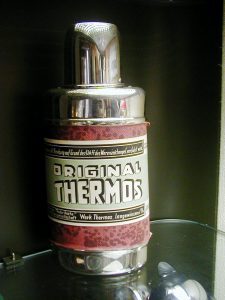Isoliergefäße – Deutsch/German

Isolierkannen und -flaschen zur Aufbewahrung von kalten und heißen Getränken finden sich in fast jedem Haushalt. Nur wenige jedoch wissen, dass die Isolierkanne, die umgangssprachlich als „Thermoskanne“ bezeichnet wird, ursprünglich zur Aufbewahrung von flüssigem Sauerstoff entwickelt wurde. Den Auftrag dafür erhielt der Berliner Reinhold Burger 1903. Er erfand die „Thermosflasche“, ein doppelwandiges Gefäß, das bis zu 24 Stunden lang die Temperatur des Inhaltes konstant hält. Als Flasche zum Warmhalten von Getränken machte er es 1908 für die Verwendung im Haushalt nutzbar und bewarb es mit dem Slogan: „Hält kalt, hält heiß – ohne Feuer, ohne Eis.“ 1909 verkaufte Burger das Patent und die Marke „Thermos“ an die Thermos AG in Berlin und die Thermos bottle Company in den USA.
Der heute älteste europäische Isoliergefäßhersteller ist die Firma „Helios Dr. Bulle GmbH & Co. KG“. Sie wurde 1909 im Thüringischen Ilmenau gegründet und ist seit 1950 in Wertheim ansässig. Auch der Isoliergefäßhersteller „alfi Zitzmann GmbH“, der heute zur WMF, der Württembergischen Metallwaren Fabrik in Geislingen, gehört, hat seit 1949 seinen Sitz in unserer Stadt. Und auch diese Firma stammt ursprünglich aus Thüringen. Sie wurde 1914 in Fischbach gegründet.
Isoliergefäße sind Vakuumgefäße. Ein Vakuum ist ein Hohlraum, der weder Wärme noch Kälte von innen nach außen leiten kann. Isoliergefäße bestehen aus zwei ineinander gesteckten Glaskolben, deren Glas-Innenseiten verspiegelt sind. Die Verspiegelung reflektiert die Wärme beziehungsweise Kälte nach innen und verhindert so die Abstrahlung nach außen. Verspiegelte doppelwandige Isolierkolben entstanden als Nebenprodukt bei der Spiegelherstellung – genau wie das Bauernsilber und der innen versilberte Christbaumschmuck.
Vacuum Flasks – English

Vacuum flasks and bottles to hold hot and cold drinks can be found in almost every household, but few people know that the vacuum flask, otherwise known as a thermos flask, was originally developed to hold liquid oxygen. In 1903, the contract for this went to a gentleman from Berlin called Reinhold Burger and he invented the “thermos bottle,” a double-walled, or lined container that kept the temperature of its contents stable for up to 24 hours. He developed it into a household bottle to keep drinks warm in 1908 and advertised it with the slogan: „ „Hält kalt, hält heiß – ohne Feuer, ohne Eis,“ which means, “keeps cold, keeps hot – without fire, without ice.“ In 1909 Burger sold the patent and the brand name „Thermos“ to Thermos AG in Berlin and the Thermos bottle Company in the USA.
Today the oldest European thermal container producer is the „Helios Dr. Bulle GmbH & Co. KG“ company. It was founded in Ilmeanu in Thuringia in 1909 and has been located in Wertheim since 1950. „Alfi Zitzmann GmbH“, another thermal container producer, which is now part of WMF, the Württemberg Metal works Factory in Geislingen, has also been located here since 1949 – another company that came from Thuringia that was founded in Fischbach in 1914.
Thermal containers are vacuum containers. A vacuum is a hollow space that doesn’t let warm or cold out. Thermal containers are made of two glass flasks placed one inside the other, with an interior mirror coating. The mirror-coating reflects the warmth or the cold back inside and prevents it escaping and was created as a by-product of mirror production – in the same way as the mercury, or „farmer’s silver,“ was used to coat the inside of Christmas tree decorations.